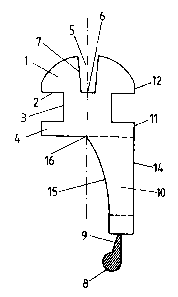Some of the information on this Web page has been provided by external sources. The Government of Canada is not responsible for the accuracy, reliability or currency of the information supplied by external sources. Users wishing to rely upon this information should consult directly with the source of the information. Content provided by external sources is not subject to official languages, privacy and accessibility requirements.
Any discrepancies in the text and image of the Claims and Abstract are due to differing posting times. Text of the Claims and Abstract are posted:
| (12) Patent: | (11) CA 2119552 |
|---|---|
| (54) English Title: | CURTAIN RAIL GLIDER |
| (54) French Title: | ACCESSOIRE POUR TRINGLE A RIDEAU |
| Status: | Term Expired - Post Grant Beyond Limit |
| (51) International Patent Classification (IPC): |
|
|---|---|
| (72) Inventors : |
|
| (73) Owners : |
|
| (71) Applicants : |
|
| (74) Agent: | SMART & BIGGAR LP |
| (74) Associate agent: | |
| (45) Issued: | 2006-02-14 |
| (22) Filed Date: | 1994-03-21 |
| (41) Open to Public Inspection: | 1994-09-25 |
| Examination requested: | 2001-01-31 |
| Availability of licence: | N/A |
| Dedicated to the Public: | N/A |
| (25) Language of filing: | English |
| Patent Cooperation Treaty (PCT): | No |
|---|
| (30) Application Priority Data: | ||||||
|---|---|---|---|---|---|---|
|
The invention comprises a glider with a head portion (1), a connecting portion (3) and a bottom portion (4), the connecting portion (3) having a smaller side than the bottom side of the head portion or the upper side of the bottom portion, the bottom portion being asymmetrical, and an eye(10), intended to bear a curtain hook towards one side, having been shifted to an outer surface (14) of the bottom portion.
L'invention concerne un patin avec une partie supérieure (1), une partie de raccordement (3) et une partie inférieure (4), la partie de raccordement (3) ayant un côté plus petit que le côté inférieur de la partie supérieure ou que le côté supérieur de la partie inférieure, la partie inférieure étant asymétrique et un anneau (10), conçu porter un crochet de rideau sur un côté, ayant été déplacé vers une surface extérieure (14) de la partie inférieure.
Note: Claims are shown in the official language in which they were submitted.
Note: Descriptions are shown in the official language in which they were submitted.

2024-08-01:As part of the Next Generation Patents (NGP) transition, the Canadian Patents Database (CPD) now contains a more detailed Event History, which replicates the Event Log of our new back-office solution.
Please note that "Inactive:" events refers to events no longer in use in our new back-office solution.
For a clearer understanding of the status of the application/patent presented on this page, the site Disclaimer , as well as the definitions for Patent , Event History , Maintenance Fee and Payment History should be consulted.
| Description | Date |
|---|---|
| Inactive: Expired (new Act pat) | 2014-03-21 |
| Inactive: Office letter | 2007-02-06 |
| Inactive: Corrective payment - s.78.6 Act | 2007-01-24 |
| Grant by Issuance | 2006-02-14 |
| Inactive: Cover page published | 2006-02-13 |
| Inactive: Final fee received | 2005-12-01 |
| Pre-grant | 2005-12-01 |
| Notice of Allowance is Issued | 2005-07-18 |
| Letter Sent | 2005-07-18 |
| Notice of Allowance is Issued | 2005-07-18 |
| Inactive: Approved for allowance (AFA) | 2005-05-27 |
| Amendment Received - Voluntary Amendment | 2005-04-05 |
| Inactive: S.30(2) Rules - Examiner requisition | 2004-10-06 |
| Amendment Received - Voluntary Amendment | 2004-08-09 |
| Amendment Received - Voluntary Amendment | 2004-07-13 |
| Inactive: S.30(2) Rules - Examiner requisition | 2004-01-14 |
| Inactive: Entity size changed | 2002-03-07 |
| Inactive: Application prosecuted on TS as of Log entry date | 2001-03-12 |
| Letter Sent | 2001-03-12 |
| Inactive: Status info is complete as of Log entry date | 2001-03-12 |
| Amendment Received - Voluntary Amendment | 2001-03-02 |
| All Requirements for Examination Determined Compliant | 2001-01-31 |
| Request for Examination Requirements Determined Compliant | 2001-01-31 |
| Application Published (Open to Public Inspection) | 1994-09-25 |
There is no abandonment history.
The last payment was received on 2005-02-11
Note : If the full payment has not been received on or before the date indicated, a further fee may be required which may be one of the following
Please refer to the CIPO Patent Fees web page to see all current fee amounts.
Note: Records showing the ownership history in alphabetical order.
| Current Owners on Record |
|---|
| FOREST GROUP NEDERLAND B.V. |
| Past Owners on Record |
|---|
| HENRIKUS WILHELMUS FREDERIKUS BOSGOED |